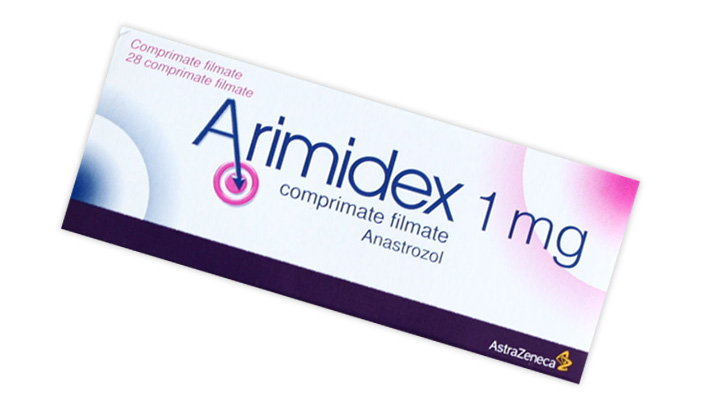Arimidex
Anastrozole is the generic name of Arimidex. It reduces the levels of estrogen in postmenopausal females. This may slow down the growth of some breast tumors which require estrogen for growing. Anastrozole is an aromatase inhibitor and is non-steroidal. Its chemical formula is C17H19N5 and the molar mass is 293.4 g/mol.

Composition and Dosage Form
1 film-coated tablet contains Anastrozole 1 mg, 14 tablets in a blister, 2 blisters in a cardboard box.
Uses
Arimidex is used for the treatment of breast cancer in women who have undergone menopause. It is mostly given to patients whose cancer has survived even after consuming Tamoxifen.
Medicine is a potent and highly selective non-steroidal aromatase inhibitor. In postmenopausal women, estradiol is mainly produced by conversion of androstenedione to estrone in peripheral tissues with the participation of aromatase enzyme, then estrone is converted to estradiol. Lowering blood levels of estradiol has a therapeutic effect in women with breast cancer. In postmenopausal women, Arimidex in a daily dose of 1 mg causes an 80% decrease in blood estradiol levels, as confirmed by a highly sensitive analytical test.
Drug does not show progestagenic, androgenic or estrogenic activity.
Arimidex in daily dose up to 10 mg/day has no effect on cortisol and aldosterone secretion, including in the standard test with ACTH stimulation. When using anastrozole, substitution administration of corticosteroids is not required.
How To Use
Arimidex is generally administered with/without meals once in a day. The dosage is one 1 mg tablet at a time.
In postmenopausal women with invasive breast cancer, in whom positive hormone receptors are detected at early stages, adjuvant endocrine treatment is recommended for 5 years.
In case of renal dysfunction, no dose adjustment is required in patients with mild or moderate renal dysfunction. Use of Arimidex in patients with severe renal impairment should be performed with caution.
In patients with mild liver disease no dose adjustment is required. In case of moderate or severe hepatic dysfunction the drug should be used with caution.
Overdose
The experience of accidental overdose of Anestrazole is limited to clinical observations. Animal studies have shown low acute toxicity of this drug. Different doses of Arimidex, up to 60 mg once daily in healthy male volunteers and up to 10 mg daily in postmenopausal men with breast cancer, have been used in clinical trials and these doses were well tolerated. No single dose of Arimidex has been found to cause life-threatening symptoms.
There is no specific antidote for the treatment of overdose, so symptomatic treatment is used. When treating an overdose, it is necessary to take into account the possibility of simultaneous administration of several substances. If the patient has not lost consciousness, it is recommended to induce vomiting. In some cases, dialysis may be useful, since Arimidex practically does not bind to proteins. General supportive treatment is recommended, including frequent monitoring of vital functions and close observation of the patient.
Side Effects
Get prompt medical treatment if you observe any of these subsequent side effects: signs of any hypersensitive reactions to Arimidex like ulcers, swollen tongue/throat/face/lips, blisters,trouble breathing, itching or hives, lesions, swelling, shortness of breath, rapid weight gain, swollen glands, bone fracture, liver disorders- upper abdominal pain, nausea, loss of appetite, clay-colored excreta, dark urine, jaundice, tiredness, symptoms of a stroke- slurred speech, sudden one-sided numbness or weakness, vision disturbances, sudden headache, balancing problems, swollen liver, infection, neoplasm, asthenia, flu syndrome, constipation, dyspepsia, cysts, gastrointestinal disorder, anemia, wrist fractures, angina pectoris, lymphedema, weight gain, arthritis, myalgia, myocardial infarction, arthralgia, anxiety, paresthesia, dizziness, spine fractures, low bone density, pharyngitis, dyspnea, bronchitis, increased cough, sinusitis, cataract, breast pain, leucorrhea, vaginitis, breast neoplasm, vaginal hemorrhage, vulvovaginitis, ischemic disease, endometrial cancer, hip fractures, extreme skin reaction- sore throat, fever, burning in eyes, red or purple rashes, skin pain, peeling of skin, hot flashes, tingling in skin, joint stiffness, joint pain, depression, mood swings, insomnia, swollen feet or ankles, back pain, high blood pressure, bone pain, blurred vision, nausea, mild rashes, vomiting or pounding in ears or neck.
Contraindications
Arimidex will not work efficiently if used along with estrogen drugs like estrogen creams, injectins, birth control pills, skin patches, vaginal rings, implants or hormone replacement treatment. You should not consume Arimidex if you are hypersensitive to anastrozole. To ensure that Arimidex is safe for use, let your doctor know if you have:
- Blood circulation problems
- Heart disease
- A history of stroke
- A family or personal history of blood clot
- Severe liver disorder
- Osteoporosis
- High cholesterol
Pregnancy And Arimidex
Although it is very unlikely for a postmenopausal female to be pregnant, Arimidex may cause harm to an unborn baby. Avoid the use of this medicine if you are or may become pregnant. It is unknown if this medication is passed into maternal milk or if it could cause damage to a nursing infant. Avoid breast-feeding while using anastrozole. Before starting the use of Arimidex, the doctor may ask you to undergo a pregnancy test to ensure that you are not pregnant.
Related Drugs
Nolvadex
Conditions:
Breast Cancer

Estrace
Conditions:
Breast Cancer

Dealing with Breast Cancer
Breast cancer happens when the cells present in the breast grow beyond control resulting in the formation of an abnormal tumor which invades the surrounding tissues. This abnormal mass of cancer cells is highly destructive, thereby it being known as malignant. The most ordinary form of breast cancer is the ductal carcinoma, which starts in the lactiferous ducts which are responsible for transporting milk to the nipples. One more kind of breast cancer is the lobular carcinoma, which begins in the mammary-gland lobules which produce milk.
1 in every 8 women in the United States suffers from breast cancer with this occurring most prominently in women over 50 years of age. This disease rarely occurs in men, but in women, this is the second leading cause of death related to cancer, post lung cancer.

Causes & Risk factors for Breast Cancer
The female hormones like estrogen & progesterone are one of the main causes of breast cancer in women. The risk factors when it comes to breast cancer include:
- Gender
- Age
- Family history with breast cancer
- Personal history with breast cancer
- Early beginning of menstruation, especially before the age of 12 or late menopause, say, after the age 55 years
- Exposure to some form of Chest radiation
- Having no children or experiencing pregnancy and child birth post the age of 30
- Ongoing use of certain oral contraceptives
- Alcohol
- Sedentary lifestyle
- Hormone replacement therapy performed for menopause
- Obesity post menopause
Symptoms of Breast Cancer
The typical breast cancer symptoms include:
- Lump formation on the breast
- Swelling or some form of redness or soreness on the breast
- Dimpling of skin
- Inversion of nipple
- Nipple discharge
- Pitting of skin
- Redness, or thickening of the nipple
- Formation of scales around the nipple
- Enlarged lymph nodes near the collarbones or under the arm.
Diagnosis of Breast cancer
While evaluation breast cancer, the following things are done:
- Breast examination
- Mammogram which is a breast x-ray
- Ultrasound test to produce the image of the breast with the use of sound waves
- Breast biopsy where a sample of the breast tissue is taken out and examined for the presence of cancer cells
- MRI scan
Treatment of Breast Cancer
Treatment using Surgery: A woman may undergo a surgery based on the severity of the cancer. These surgeries include the following types:
- Lumpectomy, which is done in early stage tumors, which involves removing the tumor but keeping the remaining breast intact
- Mastectomy, where the breast tissue is removed, thereby helping take care of larger tumors
- Double mastectomy where both the breasts of the patient are removed to ensure that the cancer does not spread beyond a certain point.
Radiation Therapy: Lumpectomy is often followed by radiation whereby cancerous cells are exposed to the laser which tends to destroy the malignant. Patients undergoing mastectomy are also sometimes exposed to radiation therapy
Chemotherapy: This is suggested when cancer is present in the lymph nodes. A patient may undergo this therapy either before the surgery to shrink larger tumors which are later removed using surgery or after the surgery to kill the unseen cells.



